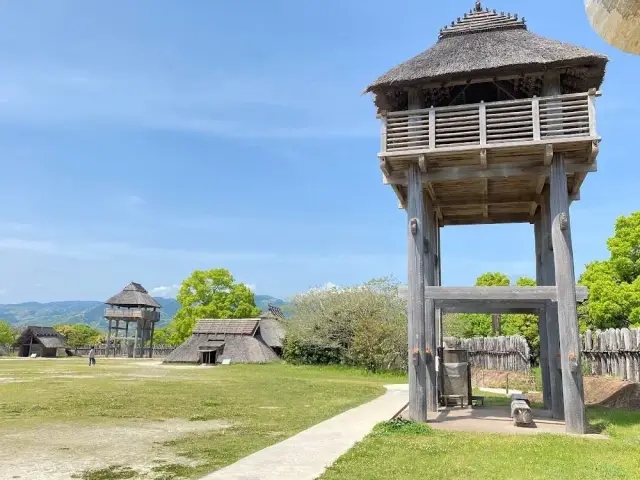https://www.dekitabi.com/itinerary/saga-day-trip-yoshinogari-historical-park
Nestled in the Saga Prefecture of Kyushu, Yoshinogari Historical Park is a captivating destination that offers a unique glimpse into Japan’s ancient Jomon and Yayoi periods. This expansive archaeological site is renowned for its well-preserved ruins and meticulously reconstructed village, making it a must-visit for history enthusiasts and travelers keen to delve into Japan’s rich cultural heritage.
Uncovering the Ancient Past at Yoshinogari Historical Park
Yoshinogari Historical Park, covering an area of approximately 200 hectares, is the largest Yayoi period settlement site in Japan. The park’s significance stems from its discovery in the 1980s, revealing a complex network of ancient dwellings, burial mounds, and artifacts that shed light on the early history of Japan. The park’s layout provides an immersive experience, allowing visitors to walk through reconstructed village settings and explore the remnants of ancient Japan.
The Yayoi Period: A Historical Overview
The Yayoi period, which lasted from around 300 BCE to 300 CE, marked a transformative era in Japanese history. During this time, Japan saw the introduction of rice cultivation, advanced metalworking techniques, and complex social structures. Yoshinogari Historical Park offers an in-depth look at this pivotal period through its various exhibits and reconstructed features. The park’s central area showcases several Yayoi-style dwellings, including pit houses and raised-floor houses, offering a tangible connection to the past.
Key Highlights of Yoshinogari Historical Park
1. Reconstructed Yayoi Village: The heart of Yoshinogari Historical Park is its reconstructed Yayoi village, which brings the ancient past to life. Visitors can explore authentic replicas of Yayoi-style houses, observe traditional farming techniques, and witness demonstrations of ancient crafts. This living history experience provides a vivid portrayal of daily life during the Yayoi period.
2. Ancient Burial Mounds: The park is home to several ancient burial mounds, known as kofun, which are integral to understanding the burial practices of the Yayoi people. These mounds, some of which are reconstructed, offer insights into the rituals and social hierarchy of ancient Japan. The burial mounds are surrounded by informative displays that explain their historical and cultural significance.
3. Artifacts and Exhibits: Yoshinogari Historical Park features an impressive collection of artifacts discovered during archaeological excavations. The park’s museum showcases a variety of items, including pottery, tools, and metal objects, providing visitors with a deeper understanding of the Yayoi period’s technological advancements and daily life.
4. Scenic Walking Trails: For those who enjoy a leisurely stroll, the park offers scenic walking trails that wind through its lush greenery and historical sites. These trails provide a serene environment for visitors to reflect on the historical significance of the area and enjoy the natural beauty of the surroundings.
5. Seasonal Events and Workshops: Yoshinogari Historical Park hosts a range of seasonal events and workshops that highlight traditional crafts and cultural practices. These events offer visitors the opportunity to engage in hands-on activities, such as pottery making and weaving, and to learn from experts about ancient Japanese techniques.
Practical Information for Visitors
Location and Accessibility: Yoshinogari Historical Park is located in Saga Prefecture, easily accessible by train and bus from major cities in Kyushu. The park’s central location makes it a convenient stop for travelers exploring the region. Additionally, ample parking is available for those who prefer to drive.
Opening Hours and Admission: The park is open daily, with extended hours during peak tourist seasons. Admission fees are modest, and the park provides a range of ticket options, including discounts for groups and special rates for children. It is advisable to check the park’s official website for the latest information on opening hours, admission fees, and any special events.
Facilities and Services: Yoshinogari Historical Park is equipped with visitor facilities, including a café and souvenir shop. The park’s staff are knowledgeable and can provide assistance with any questions or additional information about the site.
Why Visit Yoshinogari Historical Park?
Yoshinogari Historical Park offers a rare opportunity to step back in time and experience the early days of Japanese civilization. Its extensive archaeological remains, detailed reconstructions, and informative exhibits make it a standout destination for anyone interested in Japan’s history and culture. Whether you’re a history buff or simply curious about ancient Japan, Yoshinogari Historical Park provides a memorable and educational experience that enriches your understanding of Japan’s historical evolution.
In Summary
A visit to Yoshinogari Historical Park is more than just a journey through ancient ruins; it’s an immersive experience that connects you with Japan’s distant past. From the reconstructed Yayoi village to the intriguing burial mounds and fascinating artifacts, the park offers a comprehensive view of Japan’s early history. For those exploring Kyushu or interested in Japan’s cultural heritage, Yoshinogari Historical Park is a destination that promises insight and inspiration.


Leave a Reply